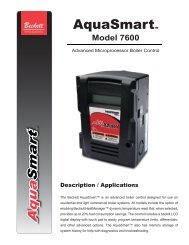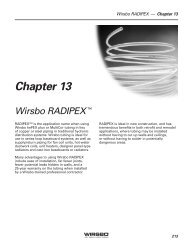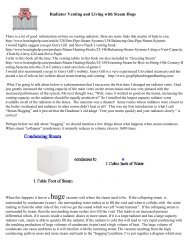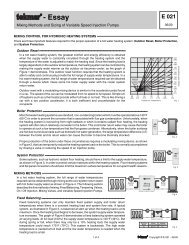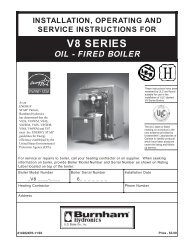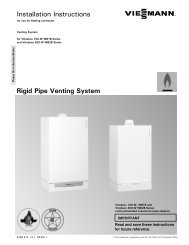Steam Locomotive Firebox Explosion on the Gettysburg Railroad ...
Steam Locomotive Firebox Explosion on the Gettysburg Railroad ...
Steam Locomotive Firebox Explosion on the Gettysburg Railroad ...
You also want an ePaper? Increase the reach of your titles
YUMPU automatically turns print PDFs into web optimized ePapers that Google loves.
cab crew, using a warning whistle that c<strong>on</strong>tinued<br />
to blow until <strong>the</strong> level of water in <strong>the</strong><br />
boiler rose or a crewmember reduced <strong>the</strong><br />
heat of <strong>the</strong> crownsheet by releasing <strong>the</strong> fire<br />
in <strong>the</strong> firebox into <strong>the</strong> ashpan.<br />
There was and is no Federal requirement<br />
that steam locomotives have low-water<br />
alarms. Opini<strong>on</strong>s about <strong>the</strong> effectiveness of<br />
low-water alarms do and did vary widely<br />
am<strong>on</strong>g steam-locomotive experts of today<br />
and railroad officials from <strong>the</strong> days of steam.<br />
Depending <strong>on</strong> <strong>the</strong> sensitivity of <strong>the</strong> alarm,<br />
locomotive crews were known to treat <strong>the</strong><br />
alarm as a nuisance and muffle <strong>the</strong> whistle.<br />
Mechanical employees found <strong>the</strong> alarms to<br />
be an additi<strong>on</strong>al burden and expense to<br />
maintain. Some railroads favored low-water<br />
alarms; o<strong>the</strong>rs did not. Some steam<br />
locomotives still operating are equipped<br />
with low-water alarms. 33 <str<strong>on</strong>g>Locomotive</str<strong>on</strong>g> 1278<br />
had no low-water alarm.<br />
Fusible Plugs--The crewmembers cannot<br />
tamper with fusible plugs, also called “drop”<br />
plugs, as <strong>the</strong>y can with low-water alarms.<br />
Fusible plugs c<strong>on</strong>sist of a short, pipe-shaped<br />
brass body that is screwed into <strong>the</strong> crownsheet<br />
at specified locati<strong>on</strong>s. (See figure 17.)<br />
Within <strong>the</strong> brass body is a brass plug held in<br />
place by a ring of fusible alloy metal that<br />
softens or melts at temperatures between<br />
500 and 575 °F. Once <strong>the</strong> crownsheet<br />
reaches <strong>the</strong> critical temperature, <strong>the</strong> ring<br />
melts and allows <strong>the</strong> brass plug to fall into<br />
<strong>the</strong> firebox, allowing steam to spray <strong>the</strong> fire,<br />
attracting <strong>the</strong> crew’s attenti<strong>on</strong>, and relieving<br />
steam pressure. Depending <strong>on</strong> <strong>the</strong> number<br />
and placement of <strong>the</strong> plugs, <strong>the</strong> activati<strong>on</strong><br />
may c<strong>on</strong>tinue, effectively preventing permanent<br />
damage or an explosi<strong>on</strong>, but at <strong>the</strong> same<br />
time disabling <strong>the</strong> locomotive. Once fusible<br />
plugs have been activated, <strong>the</strong> locomotive<br />
must be taken to a maintenance facility for<br />
repair. This disadvantage makes fusible<br />
plugs, like low-water alarms, c<strong>on</strong>troversial.<br />
As with low-water alarms, <strong>the</strong> use of fusible<br />
plugs varied widely, depending <strong>on</strong> <strong>the</strong> railroad.<br />
Federal regulati<strong>on</strong>s do not require <strong>the</strong> use<br />
of fusible plugs but do require that if <strong>the</strong><br />
plugs are used, <strong>the</strong>y must be maintained.<br />
According to <strong>the</strong> FRA’s regulati<strong>on</strong>s (49<br />
CFR 230.14, “Fusible Plugs”):<br />
If boilers are equipped with fusible<br />
plugs <strong>the</strong>y shall be removed and<br />
cleaned of scale at least <strong>on</strong>ce every<br />
m<strong>on</strong>th. Their removal must be noted<br />
<strong>on</strong> <strong>the</strong> report of inspecti<strong>on</strong>.<br />
<str<strong>on</strong>g>Locomotive</str<strong>on</strong>g> 1278 did not have fusible<br />
plugs.<br />
Oversight and Regulati<strong>on</strong> of <str<strong>on</strong>g>Steam</str<strong>on</strong>g><br />
<str<strong>on</strong>g>Locomotive</str<strong>on</strong>g>s<br />
Observers have l<strong>on</strong>g recognized <strong>the</strong><br />
dangers inherent in employing steam to<br />
power industry and transportati<strong>on</strong>. In 1863,<br />
British Royal Astr<strong>on</strong>omer George B. Airy<br />
calculated that at a pressure of <strong>on</strong>ly 60 psi,<br />
every cubic foot of boiler water has <strong>the</strong> same<br />
destructive energy as a pound of (black)<br />
gunpowder. 34<br />
55 -GPVWEM[" 4CKNYC[" /WUGWO" UVGCO" NQEQOQVKXG<br />
0Q0374." C" 3;27" 4QIGTU" 6/8/4." KU" GSWKRRGF" YKVJ" C<br />
0CVJCP"NQY/YCVGT"CNCTO0<br />
56 #KT[.")0"$0."K1P"VJG"0WOGTKECN"'ZRTGUUKQP"QH"VJG<br />
&GUVTWEVKXG" 'PGTI[" KP" VJG" 'ZRNQUKQP" QH" 5VGCO<br />
$QKNGTU" CPF" +VU" %QORCTKUQP" YKVJ" VJG" &GUVTWEVKXG<br />
'PGTI["QH")WPRQYFGT.L"2JKNQUQRJKECN"/CIC\KPG."48<br />
54;/558"*3:85+0<br />
33



